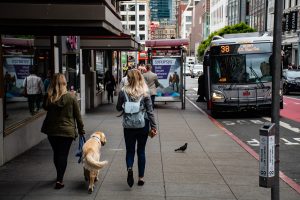We’ve often fought on the opposite side of issues from the California Department of Transportation. The legacy of smog in California is due in large part to the pursuit of an ever-expanding freeway system designed around the single passenger vehicle, with CalTrans as the agency charged with making that happen.
But over the past several months, the agency has undergone significant transformation. One big reason for this change is Governor Newsom’s appointments of Toks Omishakin as the new Director of CalTrans, and Jeanie Ward-Waller as the Deputy Director of Planning and Modal Programs. This new CalTrans leadership has created a shift the agency’s attitudes and priorities towards cleaner air, fighting climate change, and providing for clean mobility needs, and is better aligned with the governor’s vision, as expressed in Executive Order N-19-19.
SB 743 and Vehicle Miles Traveled
These new changes come at a critical time for SB 743, a 2013 law-seeking to reduce sprawl and remove barriers to infill development. Effective implementation of the law will further “statewide goals related to infill development, promotion of public health through active transportation, and reduction of greenhouse gas emissions.” Fulfilling the promise of SB 743 has taken six years and still faces opposition, but the new leadership at CalTrans and excellent work by the Office of Planning and Research have brought it close to the finish line.
This will mean environmental reviews will use reducing Vehicle Miles Traveled (VMT) as a favored metric instead of vehicle movement speed, or “Level of Service (LOS).” This seemingly obscure change in analyses should help facilitate infill, mixed-use, and transit-oriented development instead of the sprawl inducing, car dependent development that has dominated for too long.
Complete Streets
CalTrans and state transportation decision makers are increasingly prioritizing complete street efforts. Complete streets implementation will create space for all types of mobility, including sidewalks for walking, bike lanes, space for mass transit, curb-side space for shared mobility, and more.
After Governor Newsom vetoed Complete Streets legislation in 2019, CalTrans committed to active transportation infrastructure to make walking and bicycling safer and more convenient, reducing vehicle emissions that pollute our air. CalTrans recently redirected up to $100 million of SHOPP (State Highway Operations and Protection Program) funds towards complete streets elements.
During the May 13th California Transportation Commission (CTC) meeting, Director Omishakin passionately requested the Commission to “show leadership on this issue now!” and recently appointed CTC Commissioner and CCA President & CEO Joseph Lyou promised “to fight like crazy to make sure we get that $100 million for complete streets.”
Vocal support and funding for complete streets by CalTrans and other state transportation leaders marks a significant shift toward prioritizing our climate and all road users instead of just drivers.
We’re excited about this shift in priorities and attitudes, and what it will mean for the communities across the state. And we’ll keep working with our partners and CalTrans to make state transportation policy more friendly to our air and climate.









Its all about whether they can get those directives properly communicated to the line level engineers who still insist on 12 foot lanes, and the primacy of moving cars